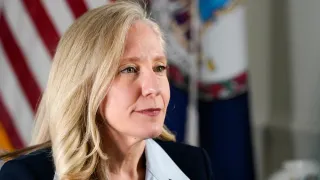September 22, 2015
Looking Back at Stonewall on Cusp of Film's Release
Kilian Melloy READ TIME: 12 MIN.
When in his second Inaugural address President Barack Obama likened Stonewall to such pivotal human rights milestones as Seneca Falls and Selma, the LGBT rights movement received the highest official recognition it had yet received. Who would have thought that the insurrection mounted by angry gay men, lesbians and drag queens on June 28, 1969 in and around Greenwich Village's Stonewall Inn would find its way into a Presidential address on the steps of the Capital?
There's an idea - incorrect but widespread - that the riots were the moment the GLTB Civil Rights Movement began. Well before the Stonewall Riots, brave men and women had stepped up to assert their right to full participation in American life and proclaim their normalcy. That the meme of Stonewall as the genesis of the LGBT civil rights movement is understandable. The Stonewall Riots have come to mark a watershed moment in American History, dividing the progress of LGBT civil rights into eras of Before and After, with "pre-Stonewall" and "post-Stonewall" now commonplace shorthand to contextualize meaningful events.
TIME Magazine has likened the riots to Rosa Parks' defining act of courage when Parks struck a blow for the dignity and equality of African Americans by refusing to move to the back of a bus. Pride events in the U.S. and abroad take place mainly in June, because that's the month in which the riots took place. Generations of sexual minorities all over the world know the name Stonewall, and have at least an idea of the events from that summer night: Hostile, homophobic police facing off with a crowd of fed-up homeless GLBT youth, gay men forced to live in the shadows, drag queens, hustlers, and other marginalized sexual minorities who had finally had enough.
Recent years have seen the release of several documentaries about the Stonewall Riots, but only now is Hollywood weighing in with a theatrical feature film. "Stonewall," a Roadside Attractions. release starring Ron Perlman, Jonathan Rhys Meyers, and Jeremy Irvine, is set to hit screens on Sept. 25. The film has been called a "labor of love" by out director Roland Emmerich. In an August 6 tweet, Emmerich tied the social climate leading up to the riots to the contemporary crisis of LGBT homeless youth, recounting that, "The circumstances that lead to LGBT youth homelessness today are pretty much the same as they were 45 years ago."
In the film, Danny (played by 25-year old British actor Jeremy Irvine), is a young man from the Midwest thrown out of his parents' house when they realize he is gay.
"He goes through this wonderful journey of finding himself, and I felt honored to help show Danny's process," Irvine told journalist Chris Carpenter in a recent interview in Rage Monthly.
Danny makes his way to New York and becomes embroiled in history in the making as the riots erupt around him. Talking about the film on Instagram, Irvine discussed how the film portrays the start of the riots, an issue of contention amongst some GLBT activists who have criticized the film based on viewing its trailer with claims that it frames the events as being spearheaded by gay white men (represented by Irvine's character).
Irvine posted that "...it is a fictional black transvestite character, played by the very talented Vladimir Alexis, who pulls out the 1st brick in the riot scene."
He was also asked by Carpenter about the controversy.
"You know, the trailer is two minutes as opposed to the two-hour movie. The movie is very careful to include all the activists involved in the riots, including (black trans woman) Marsha P. Johnson; we really tried to do justice to the story and the people who were involved."
The riots themselves were a newsworthy event, but the press stayed away because it was a show of strength by gays, and gays weren't allowed on the evening news unless it was to reiterate baseless fabrications about their "sickness" and lack of fitness for the trappings of a "normal" life. It's only been in recent years that efforts have been made to preserve accounts of how the riots started and progressed. As efforts to shed light on GLBT history continue, what's emerged is a clearer picture of just how brutal and deeply ingrained anti-gay oppression was in decades past.
It's almost an understatement to say that it was risky to come out in those days - or even speak up on behalf of gays and lesbians. Nor are today's laws far from perfect. Even though the U.S. Supreme Court federalized marriage equality in June, many states still deny GLBT citizens equal job protection under the law. In other words, a gay man or a lesbian can "get married in the morning, and be fired for being gay by afternoon." The Court's finding has also spurred a rash of anti-gay legislation designed to give homophobic bigots leave to discriminate legally against LGBTs by citing anti-gay religious beliefs. Even so, legal and social conditions for sexual minorities in America are far, far better than they used to be.
Consider: So invasive and punitive were laws targeting gays that there were even municipal regulations in New York City making it illegal for bars to serve alcohol to homosexuals. In order to get a drink, a gay man would have to patronize a place like the Stonewall Inn, nestled in the heart of the then-gay enclave of Greenwich Village, which at the time was owned and operated by people with ties to organized crime. The Mafia understood that gay men, like everyone else, enjoyed socializing over a drink, and they were happy to have gays (and their pink dollars) come to their bars. Some historical accounts claim that there was an understanding, cemented by payoffs, between the operators of such bars and the authorities; despite such supposed payoffs, however, city police raided establishments like the Stonewall, a situation that inflamed the bar's clientele.
But what made the night of June 28, 1969, different? Speculation about what triggered the riots include the summer heat and the fact that the nation was in the grip of social upheavals that included other marginalized groups standing up, sometimes forcefully, to demand their rights. One myth has it that it was Judy Garland's funeral, held the day before, that had put the bar's patrons in a volatile mood - it is said they wanted to mourn Judy, and weren't going to put up with the police crashing their sad reverie. Whatever the reason, the Stonewall Riots crystallized GLBT rage at the way sexual minorities were punished on a daily basis, simply for being who they were. It was inevitable that a moment would arrive when queers would push back.
Don't misunderstand: The situation was far worse than being a matter of where a gay man could get a cocktail. Anti-gay laws extended well beyond matters of equal service at bars. If two fellows dared so much as dance together, they could be arrested and prosecuted for it. And forget marriage equality; same-sex relations of whatever sort were steeply penalized. Any hint of sexual interest in other men could get a guy locked up or, worse, subjected to heinous medical procedures more akin to torture than therapeutic technique, all in the name of "treating" his "disease." And while today's gay scene is replete with convenient hookup apps like Grindr, back then a man seeking sexual companionship could be lured, trapped, and booked by vice cops. The press went along with this persecution all too willing, printing the full names and addresses of men brought up on "vice" charges, thus all but ensuring their domestic, professional, and financial destruction.
All of this, plus a widespread social mentality that categorically lumped gays with the mentally ill and the morally depraved, created a dangerous environment in which an episode of sexual congress was, in itself, a potentially ruinous act of defiance. The foundations for a culture of sexual freedom were laid down as a direct response to social and legal attempts to regulate what gay men did with their bodies.
But sex wasn't all there was to it. Well before the Stonewall Riots, determined men and women formed groups like The Mattachine Society and the Daughters of Bilitis to educate the world at large and argue for recognition of gays and lesbians as whole, healthy human beings, giving the lie to the pathological and pathetic fiction of homosexuals that the media - including an infamous 1967 "CBS Reports" segment hosted by Mike Wallace - represented to an uncomprehending America. The signs of an impending tipping point were there years before the riots took place; there had even been at least two smaller riots in which gays, lesbians, and transgender people clashed with police - one in Los Angeles in 1959, and one in 1966, in San Francisco.
The Stonewall Riots were different - transformationally so. Prior to June 28, 1969, most protests meant to draw attention to the plight of GLBTs consisted of well-dressed men and women carrying signs and walking in circular picket lines - a far cry from today's colorful Pride parades, replete with drag queens in feathers, muscle gods in the skimpiest of swimwear, and leather daddies in full regalia - not to mention young, committed professionals in casual wear pushing baby carriages and impeccably turned-out military servicemembers marching in crisp formation. (But guess which groups still draw the news media cameras even today?)
The sense of outrage and empowerment that bracketed the riots lingered on in the gay psyche. The first Pride parades were organized as anniversary celebrations of the Stonewall Riots. The parades gave people who had long felt isolated and invisible a new and invigorating sense of community, and thus of collective identity and strength. (The community became stronger than ever in the 1980s with the onset of the AIDS epidemic, as America's GLBTs rose to the challenge of caring for their own sick and dying comrades.) In the wake of the riots, gay activists took charge in creative ways: Nine years after the riots, the San Francisco Gay Freedom Day Parade introduced the rainbow-colored Gay Pride flag to the world.
The impact of GLBT activists was pragmatic, as well as aesthetic. Their efforts included educational outreach to the nation's psychiatrists and psychologists to demonstrate to the mental health community that, quite contrary to popular belief, gays and lesbians do in fact form lasting familial bonds - when they are allowed to do so. Under the radar, and in the cracks in heteronormative society's monolithic bulwarks, committed same-sex relationships were taking deep, enduring root. The relationships that began in the '40s, '50s and '60s matured to give rise to the much-admired couples who had been together for half a century or longer when the issue of marriage equality first started to rattle the cages of faith-based reactionary bigots in the mid-1990s, finally culminating in America's first legal same-sex marriages in 2004.
Recent years have shown quick progress for gay equality, but the journey wasn't easy. Anti-gay animus remained entrenched in American life, and the potency of the most damaging weapons of all - cultural silence and historic erasure regarding gay people and their contributions - persisted. For decades after the Stonewall Riots, the mainstream media remained unwilling to take a good, hard, objective look at what gay life was like and who gay people actually were. The task of gathering and preserving communal recollections about the riots for posterity fell to documentary filmmakers and historians well after the fact.
An acclaimed 2011 episode of the PBS documentary series "American Experience" went so far as to re-term the riots as something more respectable and positive, dubbing them the "Stonewall Uprising." That is a fitting reconsideration, because for many that uprising came to symbolize the legitimate pursuit of equal rights, protections, and opportunities as full citizens of their own country. No longer would gays tolerate their status as a despised and criminalized minority, scapegoated and blamed for the country's moral wrongs and dismissed as "weak" or "ineffectual."
Close to fifty years later, the story of the Stonewall Riots has finally been dramatized for the big screen. Some might say that is the final step toward the inclusion of the riots into the canon of mainstream Americana. The struggle for full legal and civic participation as equals in American life goes on for GLBTS, but Stonewall - while not the beginning of the quest - stands even now as a defining milestone.






